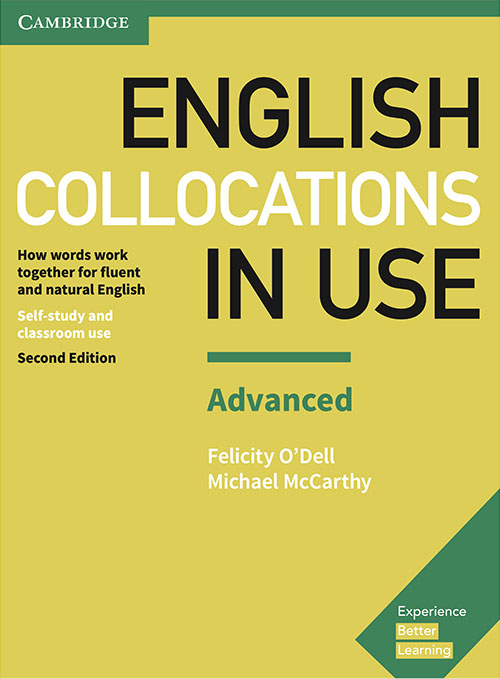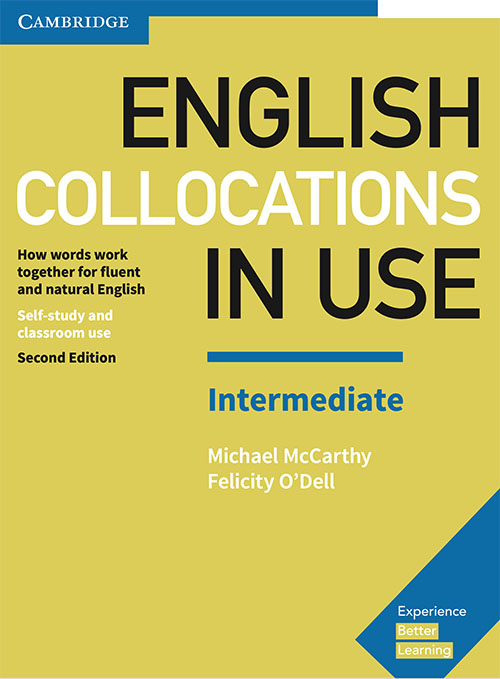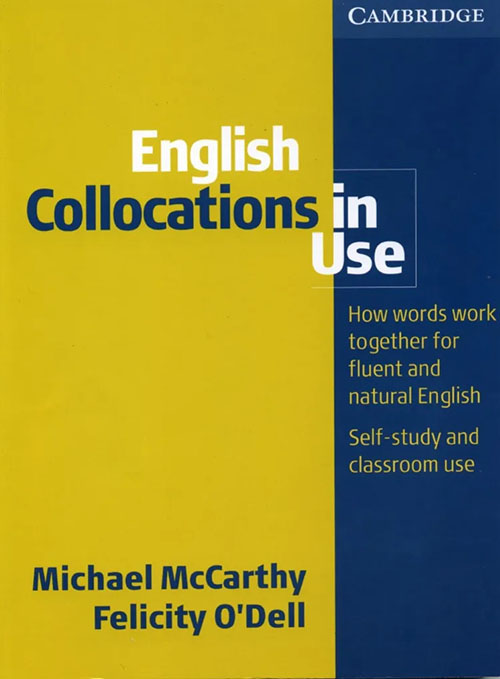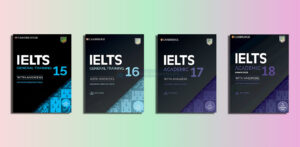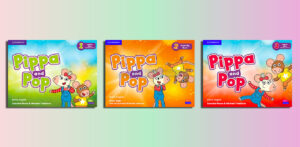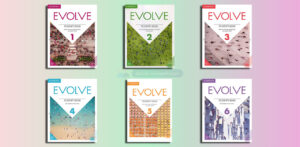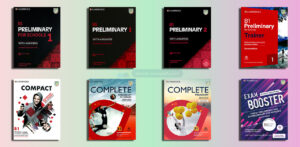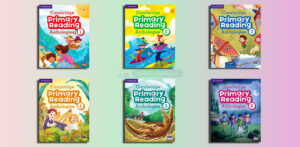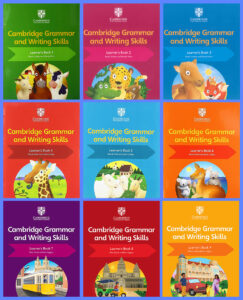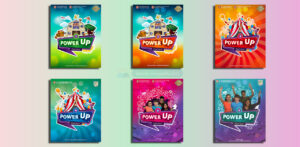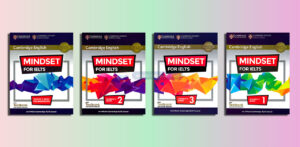Download Cambridge English Collocations in Use (4 Ebooks)
Cambridge English Collocations in Use 2005.pdf
Cambridge English Collocations in Use Advanced 2008.pdf
Cambridge English Collocations in Use Advanced 2017 (Second Edition).pdf
Cambridge English Collocations in Use Intermediate 2017 (Second Edition).pdf
✅ Get English Collocations in Use (all files): $10 for all files
After payment, please enter your email and the name of the file you want to receive.
Payment by cryptocurrency (USDT)
We accept USDT payments through the TRX Tron network (TRC20).
The wallet address is:
TRc6y3dADrs3E2VPrUDzv12VkJU7W9vTrP
After payment, please enter your email (Gmail) and the name of the file / book you want to receive.
✅ Sample pdf file English Collocations in Use 2005.pdf: Click here
✅ Sample pdf file English Collocations in Use Advanced 2008.pdf: Click here
✅ Sample pdf file English Collocations in Use Advanced 2017 (Second Edition).pdf: Click here
✅ Sample pdf file English Collocations in Use Intermediate 2017 (Second Edition).pdf: Click here
(Download the document to view it in the highest quality)
Gain access to download all resources on our website, including everything: PDFs, Audio, Video, Software, Presentation Plus, ActiveTeach IWB, Classroom Presentation Tool, iTools… for only 555 USD.
๏ You will have lifetime, unlimited access.
๏ We still continuously update resources daily.
๏ Register today at the best price.
๏ Contact us for more details (email: [email protected])
Overview of the “English Collocations in Use”
Contents
- 1 Overview of the “English Collocations in Use”
- 2 Who is suitable for ‘English Collocations in Use’?
- 3 The benefits of ‘English Collocations in Use’
- 4 Effective teaching and learning strategies for ‘English Collocations in Use’
- 5 Top Resources for Mastering English Collocations: Essential Guides and Dictionaries to Enhance Language Fluency
| ✅ Coursebook: | English Collocations in Use Second Edition |
| ✅ Authors: | Michael McCarthy, Felicity O’Dell |
| ✅ Publisher: | Cambridge University Press |
| ✅ Levels: | (Intermediate to Advanced) B1, B2, C1, C2 |
| ✅ English type: | British English |
| ✅ Publication year: | 2017 |
“English Collocations in Use” by Cambridge, authored by Michael McCarthy and Felicity O’Dell, is a specialized resource aimed at helping learners of English to understand and master collocations. Collocations, which are frequently occurring combinations of words, are crucial for achieving fluency and naturalness in English speaking and writing.
Key Features of “English Collocations in Use”
Dual-Level Approach: Catering to both intermediate (B1-B2) and advanced (C1-C2) learners, the books are structured to address the learning needs at different stages of English proficiency.
Structured Units: The books are organized into 60 two-page units. Each unit introduces collocations on the left-hand page with explanations and examples, followed by practice exercises on the right-hand page. This layout facilitates easy learning and practice.
Extensive Range of Collocations: Learners have the opportunity to explore and learn over 1,500 word combinations, significantly enriching their vocabulary and usage skills.
Contextual Learning: Collocations are taught within various themes and real-life scenarios, including topics like ‘Using the Internet’, ‘Films and Books’, ‘Social English’, and ‘Marketing’. This approach aids in understanding how collocations fit naturally into everyday language.
Research-Backed Content: The content is backed by Cambridge’s research into how English is actually spoken and written, ensuring learners are getting practical and relevant knowledge.
Examination Preparation: The books are an excellent resource for those preparing for English proficiency exams like IELTS and Cambridge English tests (First, Advanced, and Proficiency), which often assess knowledge of collocations.
Self-Study Tools: The series includes study tips, follow-up activities, and an easy-to-use answer key, making it suitable for self-study.
Second Edition Enhancements: The revised and updated second edition includes new units, ensuring that the content remains current and comprehensive.
English Collocations in Use Advanced Second Edition
Who is suitable for ‘English Collocations in Use’?
“English Collocations in Use” is suitable for a diverse range of learners who aim to enhance their proficiency in English, particularly in the area of collocations. The series caters to:
Intermediate English Learners (B1-B2 Level): For learners who have a basic grasp of English and are looking to improve their fluency and naturalness in speaking and writing. The intermediate book helps these learners understand how words combine effectively in English.
Advanced English Learners (C1-C2 Level): This book is ideal for learners with a higher level of English proficiency who wish to refine their language skills, especially in terms of using collocations correctly in more complex and formal contexts.
Self-Study Learners: Individuals who prefer to study independently will find the books helpful due to their structured approach, practical exercises, and clear explanations, along with an answer key for self-assessment.
English Language Teachers: Teachers looking for comprehensive resources to teach collocations in English classes will find these books beneficial. The varied topics and exercises can be effectively incorporated into lesson plans.
Non-Native English Speakers: Anyone whose first language is not English and who seeks to sound more natural and fluent in English can benefit from understanding and using collocations effectively.
Students Preparing for English Exams: Learners preparing for exams like IELTS, TOEFL, or Cambridge English assessments will find this series particularly useful since these exams often test knowledge of collocations.
Professionals and Academics: Professionals and academics who use English in their work and need to communicate with precision and clarity will find this resource valuable in enhancing their written and spoken language.
Language Enthusiasts: Anyone interested in deepening their understanding of English and how words are used in combination will find these books engaging and informative.
In essence, “English Collocations in Use” is suitable for a wide audience, ranging from intermediate to advanced learners, including self-learners, teachers, non-native speakers, professionals, students, and language enthusiasts. It’s a key resource for anyone interested in mastering the art of word combination in English for more effective communication.
English Collocations in Use Intermadiate Second Edition
The benefits of ‘English Collocations in Use’
“English Collocations in Use” offers numerous benefits to its learners, particularly in enhancing their proficiency in English through the mastery of collocations. Here are some of the key advantages:
Improved Language Fluency: Understanding and using collocations correctly can significantly improve fluency in English. Collocations are a vital part of natural language use, and mastering them helps learners sound more like native speakers.
Enhanced Writing and Speaking Skills: Knowing the right word combinations enables learners to write and speak more accurately and effectively. It helps in conveying ideas more clearly and naturally, which is particularly beneficial in academic and professional settings.
Better Comprehension: Learning collocations enhances reading and listening comprehension. It becomes easier to understand native speakers and authentic English texts when familiar with common word pairings.
Preparation for Proficiency Tests: Many English language proficiency exams, such as IELTS, TOEFL, and Cambridge assessments, test the ability to use collocations. Proficiency in collocations can give learners an edge in these exams.
Increased Vocabulary: The series introduces over 1,500 word combinations, significantly expanding the learner’s English vocabulary. This broader vocabulary base is crucial for effective communication.
Contextual Learning: Collocations are presented in a variety of contexts, covering a wide range of topics. This approach aids learners in understanding how collocations fit into different scenarios and subjects.
Self-Study Friendly: With clear explanations, practice exercises, study tips, follow-up activities, and an answer key, the books are excellent for self-study, allowing learners to progress at their own pace.
Cultural Insight: Many collocations are culturally rooted. Learning them can provide insights into English-speaking cultures and enhance cultural understanding.
Confidence Building: As learners become more proficient in using collocations, their confidence in using English in various contexts – social, professional, or academic – increases.
Teaching Resource: For English language teachers, these books provide a structured and comprehensive resource to teach collocations effectively in their classes.
In summary, “English Collocations in Use” is a valuable resource for anyone looking to deepen their understanding of English collocations, thereby improving their overall language proficiency. Its structured approach, coupled with practical exercises, makes it an effective tool for enhancing both spoken and written English across various levels of learners.
English Collocations in Use Advanced
Effective teaching and learning strategies for ‘English Collocations in Use’
To effectively teach and learn with “English Collocations in Use,” incorporating diverse strategies can greatly enhance the educational experience. These approaches aim to improve retention, application, and understanding of English collocations:
Contextual Learning: Present collocations in context. Use real-life scenarios, stories, or situations to demonstrate how collocations are used naturally. This method helps students understand and remember collocations more effectively.
Interactive Exercises: Engage students in interactive activities such as creating sentences, story-building exercises, or dialogues using specific collocations. This active engagement aids in embedding the collocations in their memory.
Regular Practice: Encourage daily practice of newly learned collocations. Implementing them in regular conversations, written assignments, or personal diaries can reinforce learning.
Peer Learning: Facilitate peer teaching sessions where students explain new collocations to each other. This approach can reinforce their own understanding while fostering collaborative learning.
Multimedia Resources: Utilize multimedia resources like videos, music, or podcasts that naturally include English collocations. This exposes learners to colloquial and contextually appropriate use of language.
Group Discussions: Organize group discussions or debates on various topics, prompting students to use relevant collocations. This practice can enhance their fluency and confidence in using collocations in a natural setting.
Flashcards and Visual Aids: Create flashcards or visual aids with collocations and their meanings. Visual memory aids can be very effective in learning and recalling new information.
Real-World Application: Encourage students to identify collocations in their daily reading materials such as newspapers, blogs, or books. Discussing these in class can bridge the gap between classroom learning and real-world use.
Feedback and Correction: Provide constructive feedback on the usage of collocations in spoken and written exercises. Clarify nuances and correct mistakes to improve proficiency.
Cross-Cultural Exploration: Since some collocations may have cultural underpinnings, exploring these aspects can make learning more engaging and insightful.
Customized Learning Paths: Recognize and adapt to the diverse learning styles and paces of different students. Customized approaches can address individual learning needs effectively.
Examination Practice: For students preparing for proficiency tests, incorporate exam-style questions and exercises that test collocation knowledge. This can be particularly beneficial for learners aiming to take exams like IELTS or TOEFL.
By integrating these strategies, both teachers and learners can significantly enhance the effectiveness of learning English collocations with “English Collocations in Use.” These methods not only make the learning process more dynamic and engaging but also ensure a deeper and more practical understanding of collocations in everyday language use.
English Collocations in Use
Top Resources for Mastering English Collocations: Essential Guides and Dictionaries to Enhance Language Fluency
For learners seeking alternatives to the “English Collocations in Use” series by Cambridge, which is designed to help students understand and use English collocations effectively, several educational series offer similar benefits. These alternatives aim to enhance learners’ proficiency in using natural and accurate English through focused practice on collocations and common expressions. Here are notable series that provide structured instruction, engaging content, and effective skill development:
“Oxford Collocations Dictionary for Students of English” by Oxford University Press: Provides detailed explanations of over 150,000 collocations, helping students learn the words that usually go together and how to use them accurately.
“Collins COBUILD English Collocations on the Go” by Collins: Offers learners the opportunity to familiarize themselves with common English collocations in context, aimed at improving the fluency and naturalness of their English.
“McGraw-Hill’s Dictionary of American Idioms and Phrasal Verbs” by McGraw-Hill Education: Includes a wide range of idiomatic expressions and collocations, with clear definitions and examples to help learners use them correctly in everyday conversation.
“Practical English Usage” by Michael Swan (Oxford University Press): While not exclusively about collocations, this book offers comprehensive coverage on how words work together in English, providing guidance on grammar, syntax, style, and collocations.
“The BBI Dictionary of English Word Combinations” by Morton Benson, Evelyn Benson, and Robert Ilson: This is a classic resource that lists thousands of collocations, helping learners to increase their word power and improve their chances of success in English proficiency tests.
“Longman Dictionary of Common Errors” by Pearson Education: Shows students the most common errors in word combinations and helps to correct them, which indirectly strengthens their understanding of English collocations.
“Longman Collocations Dictionary and Thesaurus” by Pearson Education: This dictionary is a resource for learning the collocations that really help increase a learner’s fluency in English, offering over 150,000 collocations and 33,000 examples.
“English Idioms and Expressions for Everyone, Yes, Even You!” by Wayne Magnuson: Although focused on idioms, this resource is valuable for understanding collocations within idiomatic expressions, enhancing both vocabulary and fluency.
“English Vocabulary in Use” by Cambridge University Press: This series includes various levels and covers not only vocabulary but also the collocations and phrases essential for effective communication.
“Idioms Organiser” by Jon Wright (published by Thomson Heinle): Organized by metaphor and topic, this book is useful for learning idiomatic expressions and their collocative structures, helping users improve their intuitive use of English.
“Speak English Like an American” by Language Success Press: Focuses on everyday expressions and collocations used in American English, offering practice through dialogues and exercises that reflect real-life situations.
“Natural English” by Ruth Gairns and Stuart Redman (Oxford University Press): Emphasizes natural-sounding English with a focus on collocations and common phrases through engaging readings and practice activities.
These resources not only improve understanding and use of English collocations but also help learners speak and write more natural and accurate English. Whether through dictionaries, practice books, or comprehensive guides, these materials are essential for anyone looking to enhance their mastery of English collocations.




